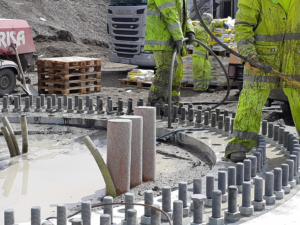Discover the Durability and Toughness of Williams Anchors for Your Next Project
Discover the Durability and Toughness of Williams Anchors for Your Next Project
Blog Article
Reliable Rock Anchors for Secure and Steady Foundations
In the world of civil engineering, the function of reputable rock anchors can not be overstated, as they are critical in developing secure and stable structures throughout a range of applications. These anchors not only facilitate lots transfer from structures to bedrock but additionally offer crucial resistance versus natural pressures, including wind and seismic task. Comprehending the different sorts of rock anchors, their certain applications, and the complexities of installment and maintenance is essential for enhancing their performance. What aspects should be considered when picking the most proper anchoring option for an offered job?
Kinds Of Rock Anchors

Passive anchors depend on the weight of the framework and the bordering dirt or rock to give resistance. Energetic anchors, on the other hand, involve the application of tension through a high-strength cable television or rod, producing a pre-stressed problem in the support - Williams Anchors.
Grouted supports are an additional substantial group, in which a steel bar or wire is put right into a pierced opening, adhered to by a cementitious cement. As soon as healed, the cement bonds with the bordering rock, developing a durable anchoring system. Each sort of rock anchor offers distinct advantages based on the details geological problems and architectural needs, thereby playing a critical function in the general stability and long life of built facilities.
Applications in Building And Construction
Rock supports play a crucial function in numerous building applications, giving crucial support and security in varied atmospheres. These ingenious options are utilized in projects ranging from massive facilities growths to smaller household structures. One of the key applications of rock anchors remains in the stablizing of slopes and preserving walls, where they aid stop soil erosion and keep structural integrity.
Additionally, rock anchors are important in securing structures for bridges, tunnels, and skyscrapers, guaranteeing they can endure side forces such as wind and seismic task. Their versatility permits installation in difficult geological problems, making them optimal for tasks in mountainous or rough surfaces.

Trick Selection Standards
Selecting the proper rock support for a particular application calls for careful factor to consider of several essential standards. Firstly, the geological problems of the website must be completely analyzed. Understanding rock type, stamina, and security is vital to make sure that the support will carry out successfully under lots problems.

Another crucial variable is the corrosion resistance of the anchor products. In settings exposed to moisture or chemicals, utilizing corrosion-resistant products will certainly prolong the lifespan of the anchors and preserve architectural honesty over time.
Furthermore, the support's installment approach should straighten with the job's requirements and restraints. Ease of installation, along with the potential effect on surrounding frameworks, need to be taken into consideration.
Setup Strategies
Efficient installation techniques are important for the effective performance of rock supports. Correct installment makes certain that the supports attain the wanted load-bearing ability and security within the geological problems. The primary step in the setup process involves site assessment, where geological studies establish the rock kind, problem, and any type of prospective challenges.
Once the site is reviewed, the ideal exploration technique need to be chosen-- options consist of rotating boring, diamond drilling, or percussion exploration. The selection depends upon rock hardness and environmental factors to consider. Precise boring depth and angle are vital to ensure that the supports line up with structural needs and tons distribution.
After exploration, the next phase entails cleaning up the borehole to eliminate debris, which can endanger bond stamina. Following this, the anchor is put, and if called for, a grout or resin is infused to improve adhesion. The curing time of these products helpful resources should be followed, ensuring that the anchors attain complete strength prior to any lots is applied.
Upkeep and Evaluation
Correct maintenance and inspection of rock supports are necessary to guarantee their long-lasting efficiency and reliability (Williams Anchors). Normal evaluations aid determine any kind of potential concerns, such as rust, variation, or structural exhaustion that could jeopardize the honesty of the anchoring system
Routine assessments should be carried out at defined intervals, taking into consideration ecological elements and the details application of the rock anchors. Visual evaluations need to concentrate on the subjected areas of the supports, looking for indications of corrosion, splits, or other anomalies. Furthermore, it is critical to evaluate the surrounding my link geological problems to identify any shifts in soil or rock that may impact support efficiency.
Sometimes, more sophisticated methods such as lots screening or non-destructive screening might be warranted to determine the anchors' load-bearing capability and general health and wellness. Correct documents of inspection searchings for, upkeep activities, and any repairs or replacements carried out is important for continuous assessment and compliance with market requirements.
Final Thought
To conclude, reputable rock anchors play an important duty in making sure secure and steady structures throughout various building and construction applications. By efficiently transferring lots and enhancing stability against side pressures, these anchors contribute significantly to the durability and honesty of structures such as bridges, passages, and preserving walls. Strategic choice, installation, and maintenance of rock anchors are important for maximizing performance and safeguarding public security, ultimately highlighting their importance in modern-day design techniques.
Report this page